Welcome to Tyrol! Here you’ll find a region of Austria where jagged peaks meet rolling meadows. Where tradition intertwines seamlessly with modern alpine life. If you’re piecing together a travel guide to unearth the best things to do, you’ve come to the right spot. Tyrol’s charm spans centuries-old farmhouses, hearty mountain cuisine, and breathtaking vistas that redefine “picture-perfect.” But it’s more than just scenic postcards. You’ll be charmed by folk music, artisanal crafts, and warm hospitality.
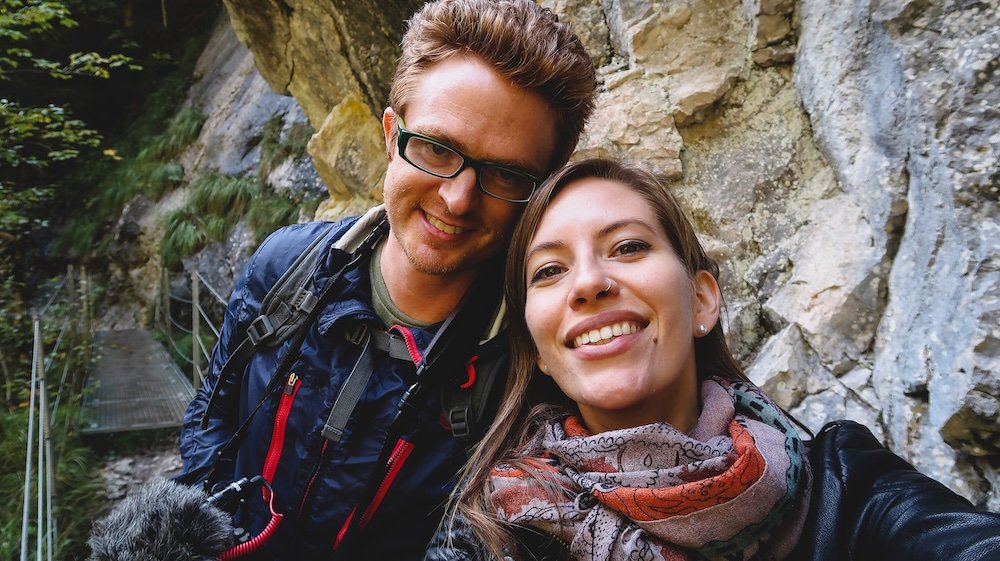
Trip planning can be stressful. You might worry about language barriers, the cost of accommodation, or whether you’ll find enough variety to keep everyone in your group happy. Tyrol’s mountainous geography might also spark questions—do you need a car? Are there enough winter or summer activities if you’re not a hardcore skier or hiker? This guide aims to erase those doubts.
Our Travel Video From Tyrol, Austria on Samuel and Audrey YouTube Channel: Nomadic Samuel + That Backpacker as hosts
Why Tyrol?
Whether you’re an adventurous soul seeking challenging alpine treks or a leisure traveler hankering for a calm rural retreat, Tyrol caters to a broad audience. Families will find plenty of child-friendly hikes and cultural festivals. Foodies can chase artisanal cheeses and sweet Pruegeltorte demonstrations, while couples or solo adventurers can bask in the serenity of hidden valleys or scenic gondola rides. Essentially, if you love crisp mountain air, hearty meals, and a sense of authentic local culture, Tyrol will tickle your fancy.
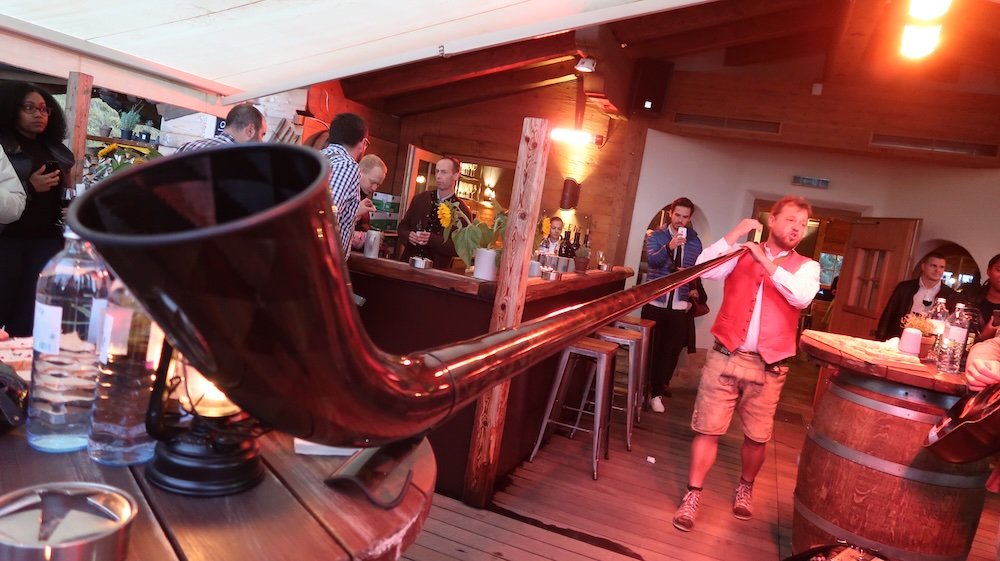
Tyrol stands out for its blend of scenic drama, rustic farm traditions, and hearty hospitality. Majestic peaks tower over storybook villages, each corner revealing a fresh perspective—be it a hidden waterfall, a local festival, or a comforting bowl of dumplings. Below, we dive into the Top 14 Things To Do, from farmhouse stays to hiking through spectacular gorges. Afterwards, we’ll discuss local eats, tours, lodging options, transport tips, and final musings to cap your trip plans. Ready? Let’s ascend into Tyrol’s alpine embrace.
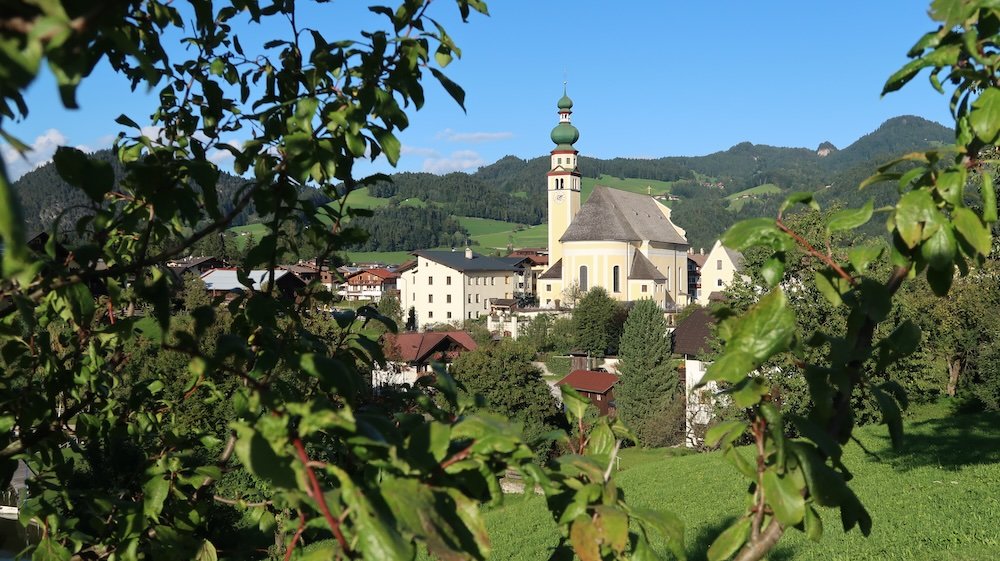
Top 14 Things To Do in Tyrol, Austria For Visitors
Tyrol brims with alpine charm, lively customs, and a down-to-earth spirit. Below are 14 recommended experiences to deepen your connection with this Austrian region.
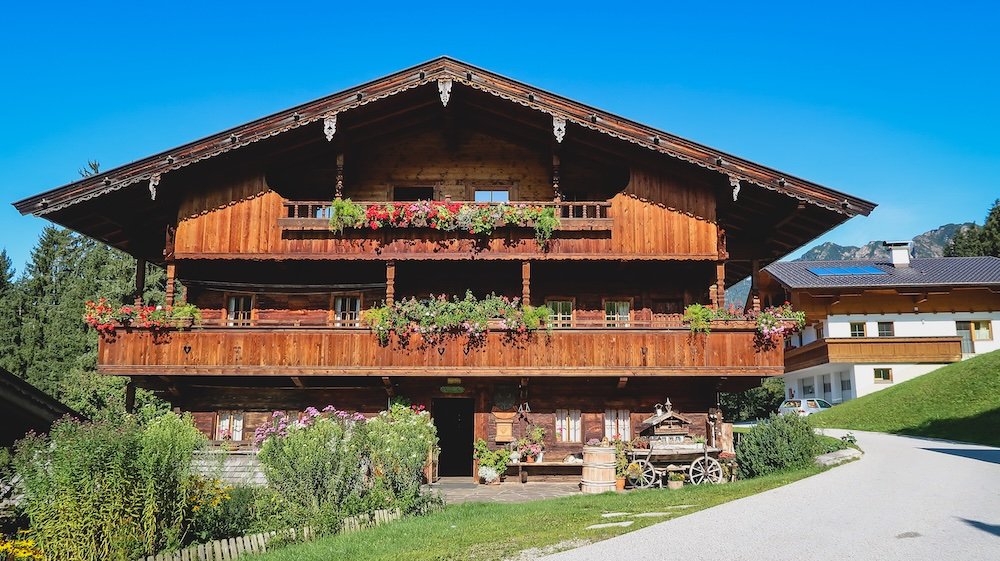
1) Stay in a Traditional Tyrolean Farmhouse
Waking up in a traditional Tyrolean farmhouse offers a unique gateway into local life. Imagine wooden floors that creak with history, floral balconies overlooking misty valleys, and the aroma of fresh bread drifting from a cozy kitchen. In many villages, families open their homes to guests, showcasing cherished heirlooms and stories passed through generations. These farmhouses often feature shared breakfasts, where homemade butter and jam transform your morning. By night, you hear cowbells faintly chiming beyond your window—nature’s own lullaby. It’s a living tapestry of warmth and authenticity, reminding you that tradition here isn’t just displayed; it’s lived daily.
- Amenities: Private or shared rooms, hearty breakfasts, sometimes with optional farm activities.
- Booking: Directly via local tourism boards or farmstay websites; limited capacity ensures a tight-knit vibe.
- Atmosphere: Expect genuine hospitality, with hosts eager to share regional customs.
Tip: Ask if you can help with small farm chores—like collecting eggs or feeding goats—for an even richer immersion.
![]()
2) Tyrolean Food (Kasspatzen) at Kaiserhaus Gasthof in Brandenberg
At Kaiserhaus Gasthof in Brandenberg, you’ll encounter Kasspatzen—an iconic Tyrolean comfort food that resembles cheesy dumplings. The dish comprises flour dumplings doused in melted local cheese, then topped with crispy fried onions for a savory crunch. Savoring a plate near a rustic wooden table, you’ll sense how Tyrolean cuisine bridges simplicity and sustenance in one hearty bite. The Gasthof’s cozy interior features vintage farmhouse décor and maybe a wood-burning stove radiating warmth. Locals pair Kasspatzen with a crisp green salad or tangy sauerkraut, balancing out the richness. Tucked in a scenic valley, Kaiserhaus Gasthof exemplifies how good food and nature’s calm can merge seamlessly.
- Menu Highlights: Beyond Kasspatzen, you might spot speck dumplings or apple strudel.
- Drinks: Typically beer or a carafe of herbal tea brewed from mountain herbs.
- Friendly Staff: Many speak English, happy to guide you through Tyrolean delicacies.
Tip: Request a window seat if possible—the gentle mountain views elevate each forkful.
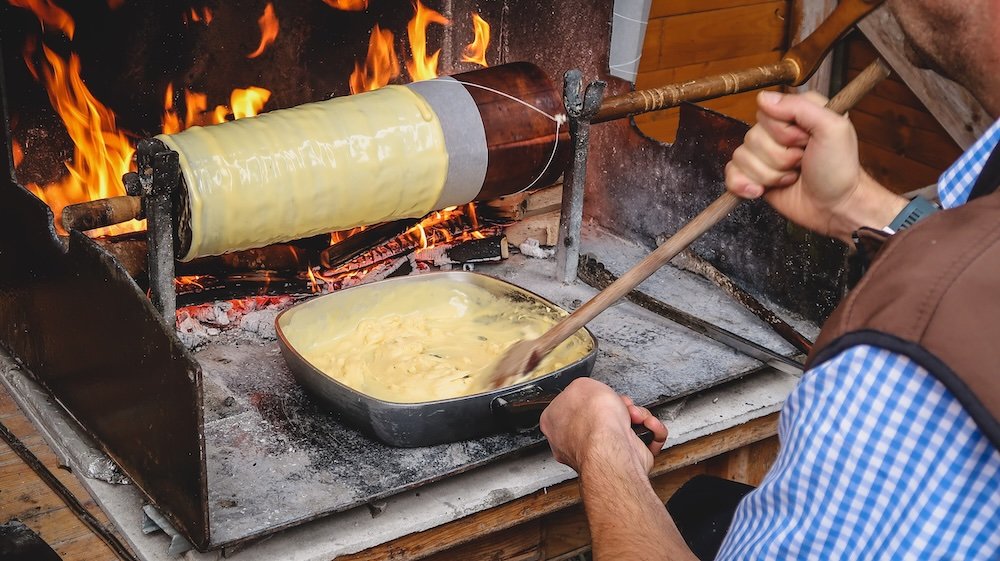
3) Pruegeltorte (Tyrolean Cake) Cooking Demonstration
Pruegeltorte stands out as a cylindrical Tyrolean cake baked on a rotating spit. Watching a cooking demonstration reveals the artistry—thin batter layers build up over time, forming delicate rings that appear almost like bark. Sweet aromas fill the air as you witness the rotation, meticulously tended by skilled bakers. Once done, slices reveal a mesmerizing cross-section of golden lines. Tastings are typically part of the demo, letting you relish subtle sweetness and a pleasingly firm texture. It’s a dessert seldom seen outside Austria, so learning the technique—and tasting fresh slices—feels extra special.
- Where: Many Tyrolean pastry shops or local cultural centers hold demos.
- Consistency: Crisp exterior with a soft, layered interior, often dusted with powdered sugar.
- Adaptations: Some modern versions introduce chocolate or nut fillings.
Tip: Check seasonal schedules—tourist boards often list demonstration dates, ensuring you won’t miss this rare show.
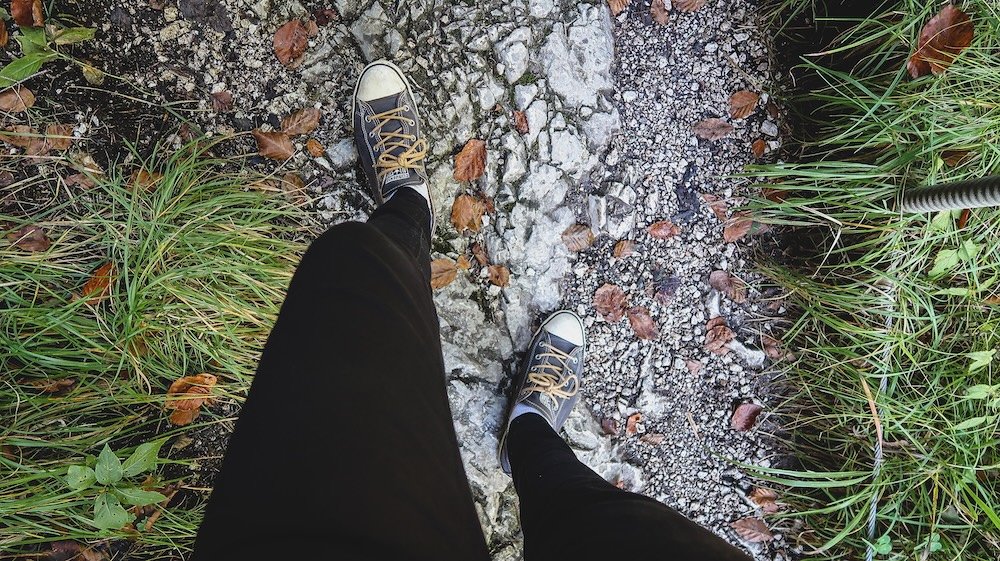
4) Hiking the Kaiserklamm Gorge in Tyrol
The Kaiserklamm gorge in Tyrol slices through dramatic limestone cliffs, where turquoise waters rush below wooden walkways and footbridges. The hiking path meanders along the ravine’s edge, occasionally hugging the cliff face—thrilling but still manageable for reasonably fit adventurers. You’ll pass waterfalls cascading into churning pools, sending up a cool mist that refreshes tired legs. Sunbeams peek through overhead branches, highlighting mossy boulders like an enchanted forest scene. In sections, you might see kayakers braving the rapids, adding a splash of adrenaline to the gorge’s pristine calm. As you complete the loop, you’ll appreciate Tyrol’s knack for blending natural spectacle with accessible trails.
- Trail Difficulty: Moderate; some narrow passages and slick rocks demand sturdy shoes.
- Timing: Morning visits are quieter, though midday brings more sunshine into the gorge.
- Parking: A small lot near the trailhead—arrive early to secure a space.
Tip: Carry a lightweight jacket—the gorge can be chilly and damp, even in summer.
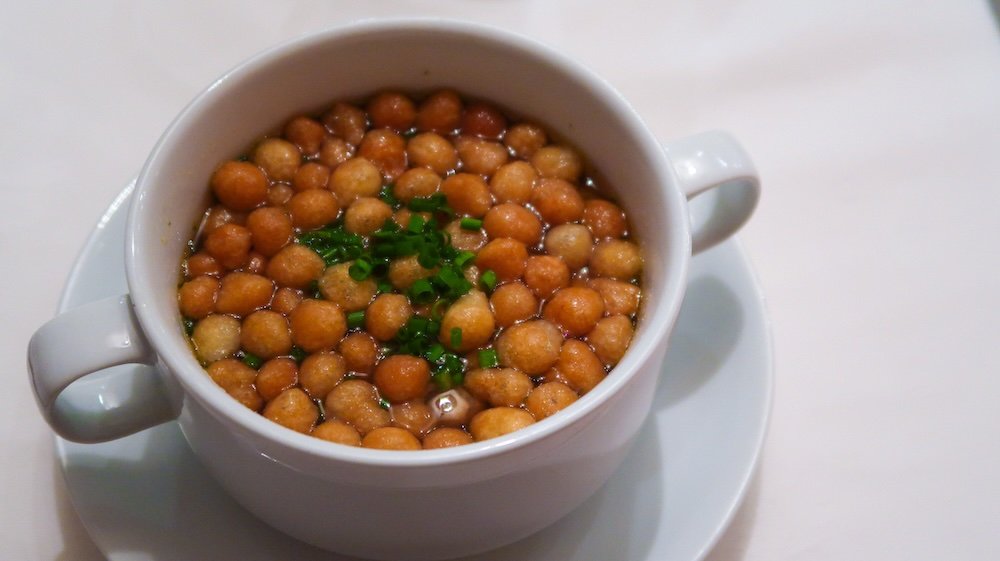
5) Dinner in Reith im Alpbachtal with Live Music
Reith im Alpbachtal prides itself on rustic mountain dining, often accompanied by live folk tunes. Stepping into a local inn, you’ll encounter checkered tablecloths, waitstaff in Dirndls or Lederhosen, and a menu loaded with regional specialties—speck, dumplings, or creamy soups. When the band starts, accordions and violins fill the air, blending melodic tales of rural life. Locals clink beer steins, occasionally singing along to centuries-old tunes. Between bites, you might chat with neighbors who offer tips on tomorrow’s best hike. By evening’s end, your belly’s full and your spirits lifted by Tyrol’s warm camaraderie.
- Cultural Flare: Performers may don traditional outfits, amplifying the ambiance.
- Cuisine: Hearty dishes like roast pork or knödel (dumplings), plus sweet plum desserts.
- Atmosphere: Expect laughter, communal toasts, and maybe spontaneous dancing if the mood strikes.
Tip: Check event listings—some inns schedule music just on weekends or special occasions.
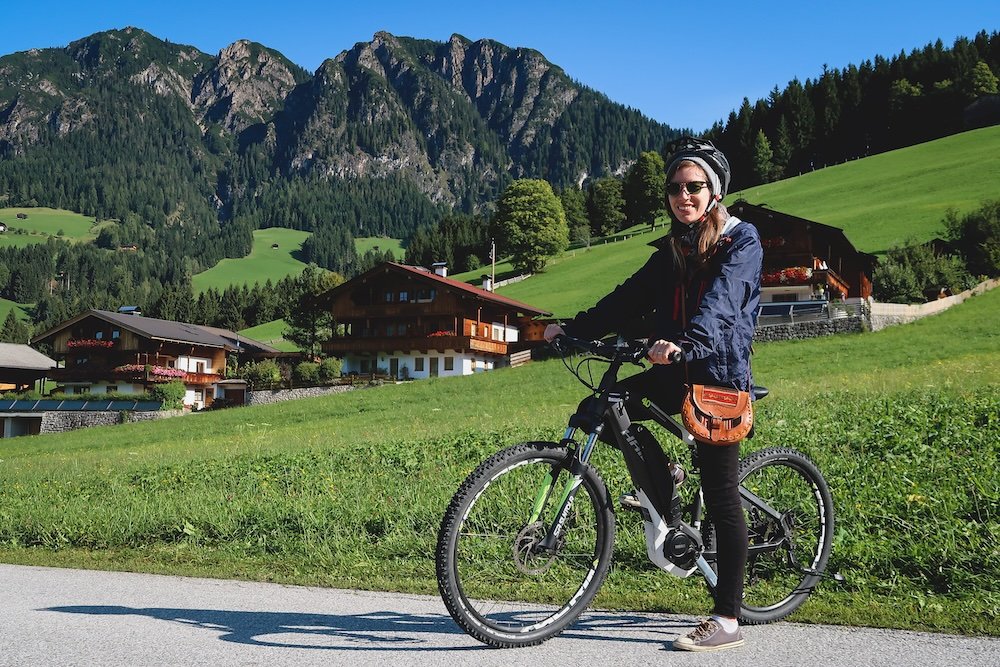
6) E-Biking in Tyrol Around Alpbach in the Austrian Alps
Alpbach—famed for floral balconies and chalet-style architecture—serves as a scenic hub for e-biking. Renting an electric-assisted bike saves energy on hills, allowing you to breeze through meadows and ascend modest mountain roads without constant panting. En route, you’ll pass farmsteads with cows grazing by wooden huts, while panoramic peaks frame your view. E-biking offers both the thrill of cycling and the comfort of pedal assistance, perfect for mixed fitness levels or extended day tours. Villagers you pass might greet you with a friendly “Grüß Gott,” reaffirming Tyrol’s welcoming vibe. As you roll back into Alpbach, you’ll feel an exhilarating sense of accomplishment.
- Equipment: Helmets, gloves, and e-bike rentals available at local shops; battery life usually covers daily routes.
- Path Variety: Choose gentle loops or advanced climbs, guided by well-marked signage.
- Photo Moments: Scenic vantage points galore—pack a phone or small camera.
Tip: Check weather forecasts—afternoon storms can blow in unpredictably, so plan rides for early morning or keep an eye out for sudden clouds.
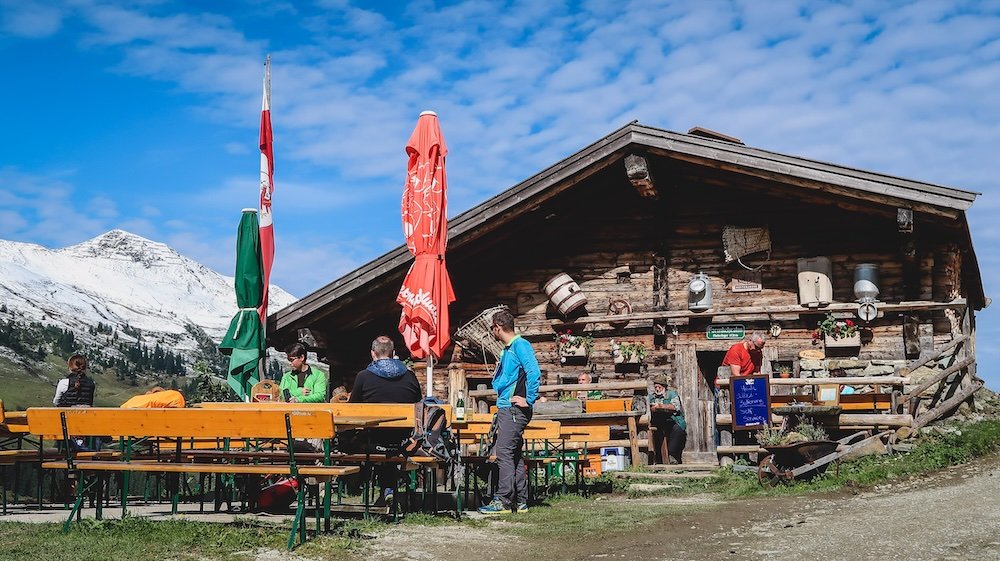
7) Farmkehr Alm Mountain-Top Restaurant Overlooking Alps
Perched high above the valley, Farmkehr Alm treats visitors to panoramic mountain vistas plus traditional Tyrolean fare. Reaching it typically involves a short hike or cable car ride, building up an appetite for robust soups, cured meats, and homemade pastries. The open-air deck extends the dining room skyward, letting you feast amid crisp breezes and sweeping peaks. Go midweek for fewer crowds, or weekends for a buoyant, communal vibe. Friendly staff often regale you with local stories or cooking tips. Every mouthful—be it piping hot goulash or freshly baked cake—tastes better under the Alpine sun.
- Menu Highlights: House-made spätzle, smoked ham, and sweet Germknödel dumplings.
- Child-Friendly: Kids get a kick out of the simple climbing areas or wandering goats (if any roam nearby).
- Panoramic Photos: The vantage is unstoppable, so keep your camera at the ready.
Tip: Book a table if you’re visiting midday in peak season—limited seating can fill quickly.
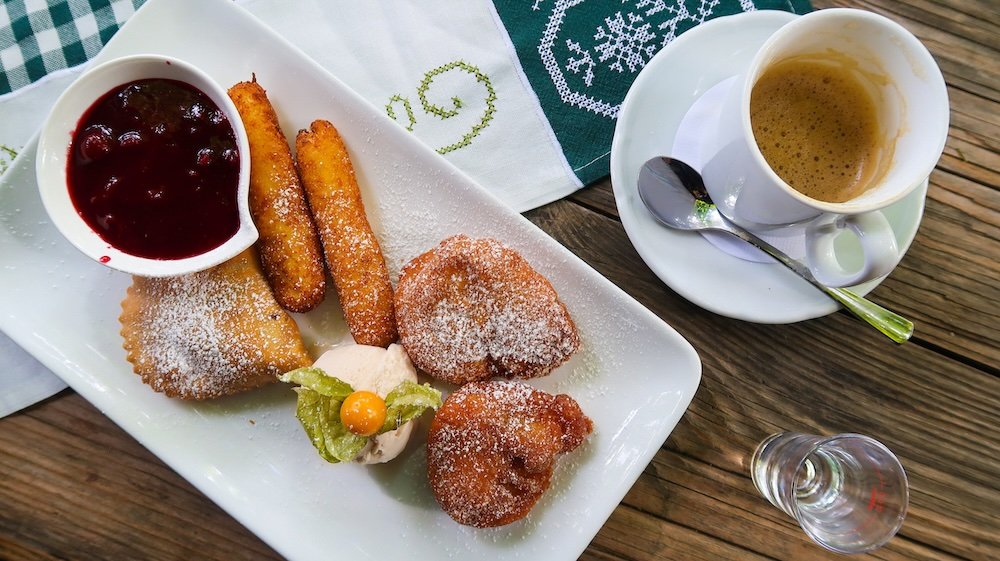
8) Eating Tyrolean Desserts at Rohrerhof in Kramsach
Rohrerhof, nestled in Kramsach, is famed for sweet indulgences like Apfelstrudel, Topfenstrudel, and seasonal fruit tarts. The building exudes farmhouse charm, with wooden accents and vintage farm tools adorning walls. Each dessert is prepared with local eggs, flour, and fruit, ensuring fresh flavors in every bite. Pair your treat with a coffee or house-made schnapps for a delightful afternoon pick-me-up. Rohrerhof’s terrace overlooks a gentle slope of farmland, complementing that last forkful of pastry. It’s a slice of rural heaven, blending old-world recipes with picturesque surroundings.
- Seasonal Variation: Strawberry or rhubarb pastries pop up in spring, plum or berry combos in late summer.
- Portion Sizes: Typically generous—one slice might suffice, though sweet tooth travelers may disagree.
- Hospitality: Expect a smile and willingness to share background on each dessert’s heritage.
Tip: Try the Topfenstrudel—the tangy quark cheese sets it apart from the usual apple strudel.
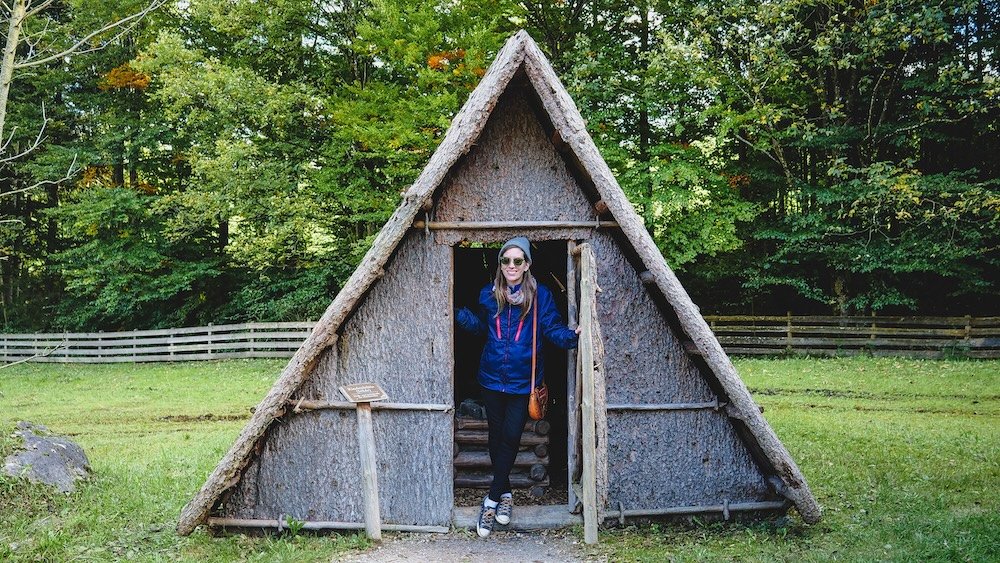
9) Tyrolean Farmhouse Museum (Museum Tiroler Bauernhöfe)
At the Museum Tiroler Bauernhöfe in Kramsach, centuries of rural heritage unfold across a sprawling open-air site. Traditional homes, mills, stables, and chapels from various Tyrolean valleys were dismantled and reconstructed here, preserving authentic architecture. Wandering from building to building, you witness how families once lived: low ceilings, robust wooden beams, and central ovens that doubled as a hearth. Exhibits detail domestic life—looming, cooking, milking chores—giving context to Tyrolean resilience in harsh alpine conditions. Often, costumed guides demonstrate old crafts like weaving or bread-baking. This immersive time capsule leaves you with newfound respect for the region’s enduring spirit.
- Kid-Friendly: Hands-on corners let children explore interactive displays.
- Photography: The rustic textures—woodgrain, thatch roofs—are perfect for atmospheric shots.
- Cafe on-Site: Refuel with coffee, pastries, or a hearty soup made in farmhouse style.
Tip: Allocate a couple of hours—the site is larger than it appears, and each building offers unique glimpses of Tyrolean life.
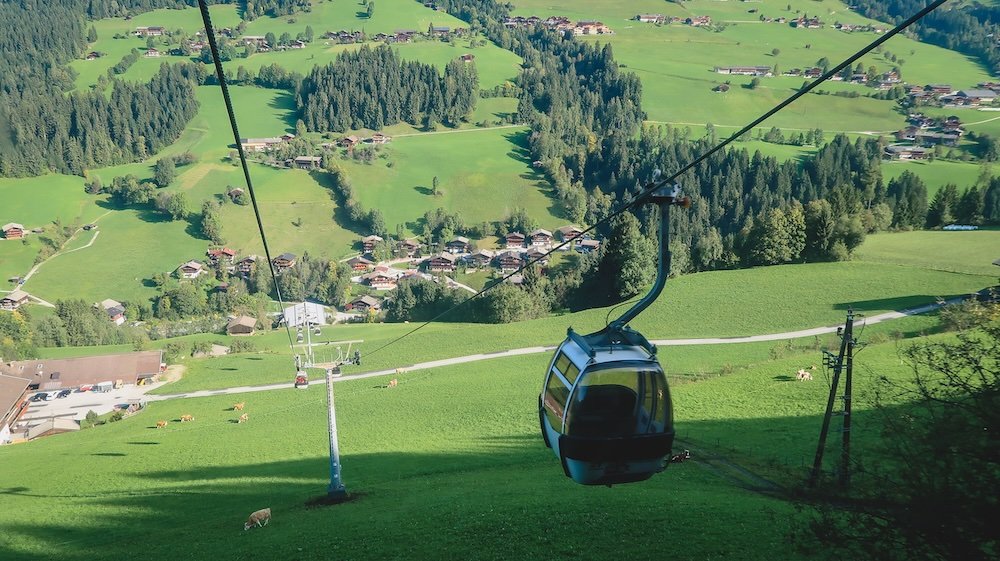
10) Gondola Ride to Wiedersbergerhorn
For lofty panoramas minus a strenuous climb, take a gondola to Wiedersbergerhorn near Alpbach. The ride carries you above forests and pastures, unveiling ever-broadening vistas with each passing minute. Once at the top station, you can wander around short loop trails, seeking vantage points that overlook valleys and distant peaks. If time permits, enjoy a warm beverage in a mountain hut or snap selfies with playful goats. The tranquility up here feels worlds away from busy roads, enveloping you in crisp alpine air. Come summer or winter, Wiedersbergerhorn’s gondola invites you to savor Tyrol’s high-altitude magic with minimal effort.
- Season Options: Summer highlights lush meadows; winter offers ski slopes and a snowy wonderland.
- Trail Variety: Gentle strolls for novices, plus moderately steep hikes if you want more challenge.
- Operating Hours: Typically morning to late afternoon—verify exact times, especially off-season.
Tip: Arrive mid-morning for fewer crowds—giving you prime access to photo spots and hut seating.
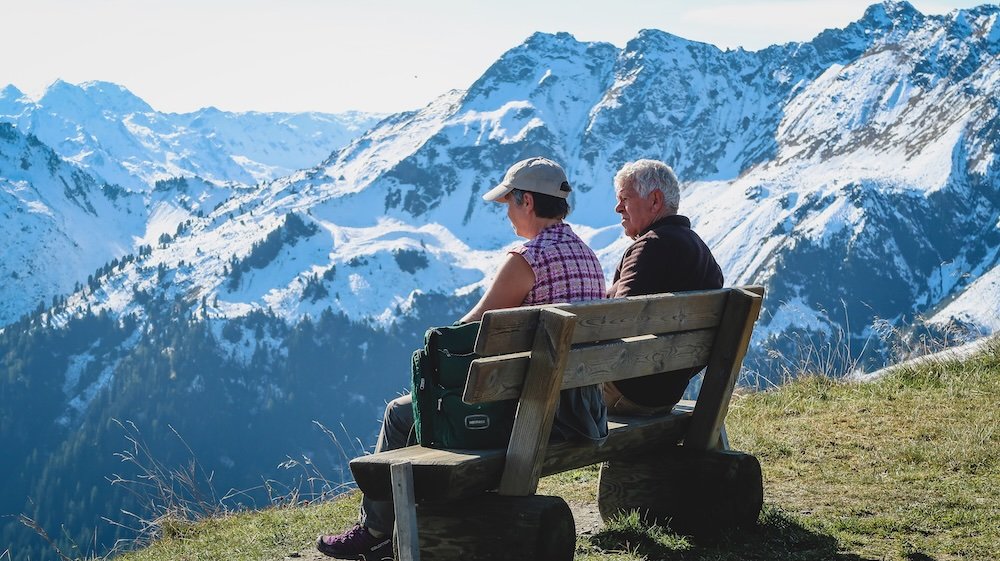
11) Hiking in the Austrian Alps (Wiedersbergerhorn)
If the gondola ride lures you upwards, continue with a Wiedersbergerhorn hike to fully immerse in Alpine grandeur. Trails meander around ridges, offering eagle’s-eye glimpses of Alpbach below. Wildflowers dot the terrain, and occasional benches let you pause, breathe, and maybe nibble on trail mix or local chocolate. At higher altitudes, you might cross small snow patches even in late spring, reminding you how the mountains do their own thing. Keep your camera ready for goats or marmots scuttling near rocky outcrops. Finishing the loop, your lungs feel cleansed by pine-scented air, while the panoramic payoff lingers in your mind’s eye.
- Difficulty: Several loops cater to different fitness levels—from relaxed to strenuous.
- Weather: Conditions can shift swiftly in the Alps, so dress in layers and pack a rain jacket.
- Wildlife: Keep a respectful distance from animals to avoid disturbing their habitat.
Tip: Bring trekking poles—they aid stability on uneven paths, especially during descents.
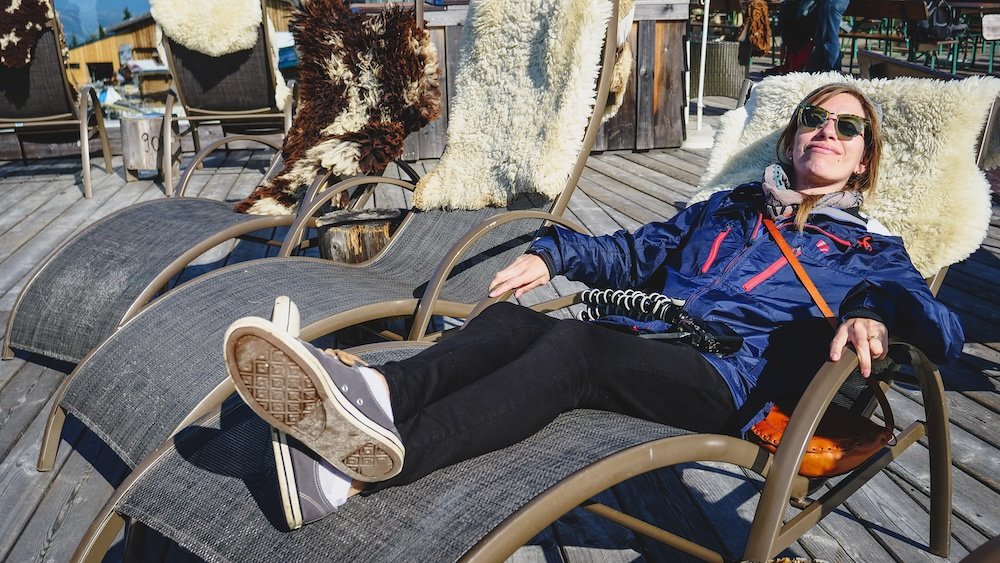
12) Coffee with Mountain Views
Sometimes, the simplest Tyrolean joy is savoring coffee on a terrace that frames towering peaks. Pick a café perched atop a hillside or near a gondola station, order a melange (similar to a cappuccino) or an espresso, and just sit back. Crisp mountain air amplifies every sip, and the hush of nature feels calming. Locals might chat softly in dialect, or travelers compare hiking notes in hushed excitement. Birds occasionally swoop past, adding a flicker of motion to the stillness. This small ritual underscores that in Tyrol, slowing down is its own reward.
- Cafe Scenes: Some belong to big hotels, others are independent huts or family-run spots.
- Menu: Alongside coffee, expect pastries or light snacks, like cheese bread or strudel slices.
- Indoor Option: If weather’s fickle, cozy interiors still afford grand window views.
Tip: Embrace the moment—resist phone-scrolling, soak up the ambiance, and let Tyrol’s tranquility recalibrate you.
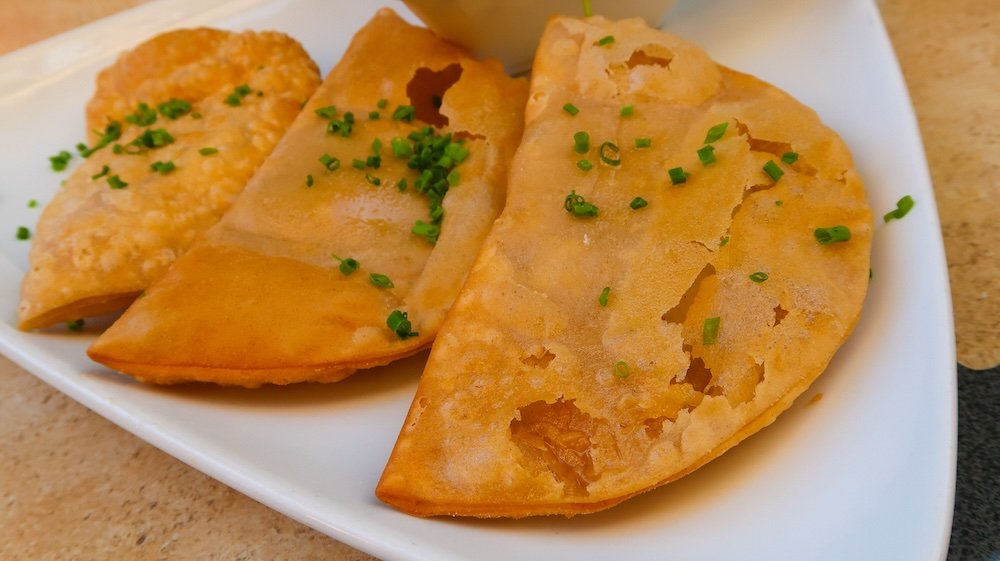
13) Lunch in Reith im Alpbachtal
Reith im Alpbachtal invites midday satisfaction, courtesy of local inns and sun-washed terraces. Many restaurants highlight speck, dumplings, and crisp salads drawn from fresh produce grown nearby. Since Reith is more intimate than bigger tourist towns, you’ll likely see families strolling with strollers or seniors enjoying slow-paced lunches. If you snag an outdoor seat, watch as mountains rim the horizon, forming a protective alpine wall. Engaging waitstaff frequently offer suggestions—like a house-special soup or homemade dessert. It’s an easy way to sense Tyrol’s communal vibe, where meals unite neighbors and visitors alike.
- Regional Drinks: Try an apple spritzer or elderflower soda for a refreshing non-alcoholic choice.
- Kids’ Menus: Many local joints cater to children with smaller portions or simplified favorites.
- Timing: Avoid the 1 PM rush if possible—arriving earlier yields less wait time.
Tip: Seek daily specials posted on chalkboards—they’re often cheaper and reflect what’s freshest that day.
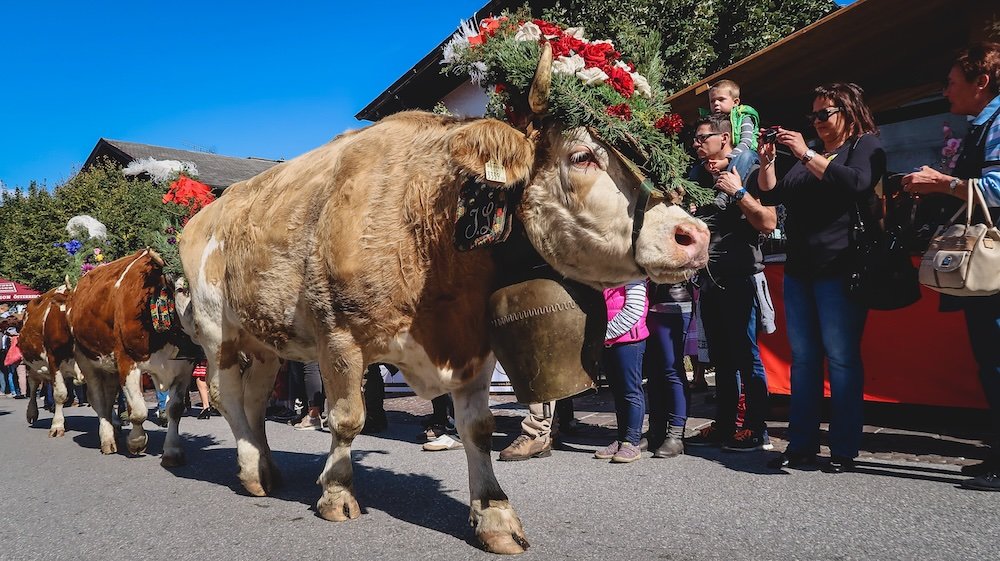
14) Almatrieb “Cows Come Home Parade”
Nothing cements Tyrolean culture quite like the Almatrieb, a festive parade marking cows’ return from alpine pastures in late summer or autumn. Farmers adorn their cows with garlands of flowers and ribbons, parading them through village lanes to melodic cowbells. Spectators line streets, cheering or snapping photos as herders pass in Dirndls and Lederhosen. After months grazing in high meadows, the cows come “home” for winter, symbolizing a successful season of abundant grass and mountain air. Stalls often pop up selling local cheese, strudel, and schnapps. This colorful custom reveals deep reverence for rural life—a joyous bond between humans, animals, and the land.
- Locations: Many Tyrolean villages hold separate events, so check local calendars.
- Atmosphere: Think street festival meets rustic folk tradition—music, dancing, and hearty laughter.
- Timing: Typically mid-September to early October, though dates vary by region’s grazing schedules.
Tip: Arrive early—front-row vantage points vanish quickly, especially if you want close-up photos of the bedecked cows.
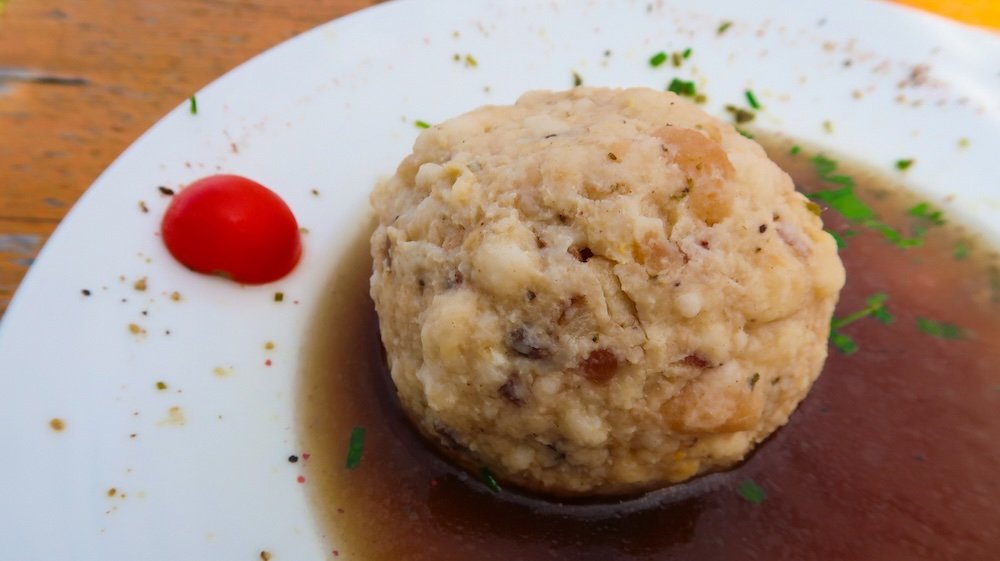
What To Eat and Drink in Tyrol, Austria
Food in Tyrol merges hearty mountain fare, fresh dairy, and centuries of tradition. Whether you’re devouring dumplings in a rustic hut or sampling orchard fruits at a village market, the region’s cuisine is deeply tied to its alpine environment. Below is an overview to guide your gastronomic explorations:
Hearty Tyrolean Staples
- Kasspatzen: A pasta-like dish with melted cheeses—often Emmentaler or Bergkäse—topped with crispy onions. It’s a ski-lodge favorite that recharges you after a day on the slopes.
- Speckknödel: Savory bread dumplings incorporating Tyrolean speck. Served in soup or drizzled with butter, they highlight how local bacon can transform simple dough into magic.
- Gröstl: A skillet-based medley of potatoes, onions, and leftover meats, pan-fried into a golden, satisfying blend.
Tip: Pair these with a refreshing beer or a small side salad—these dishes are rich, so a crisp beverage offsets the indulgence.
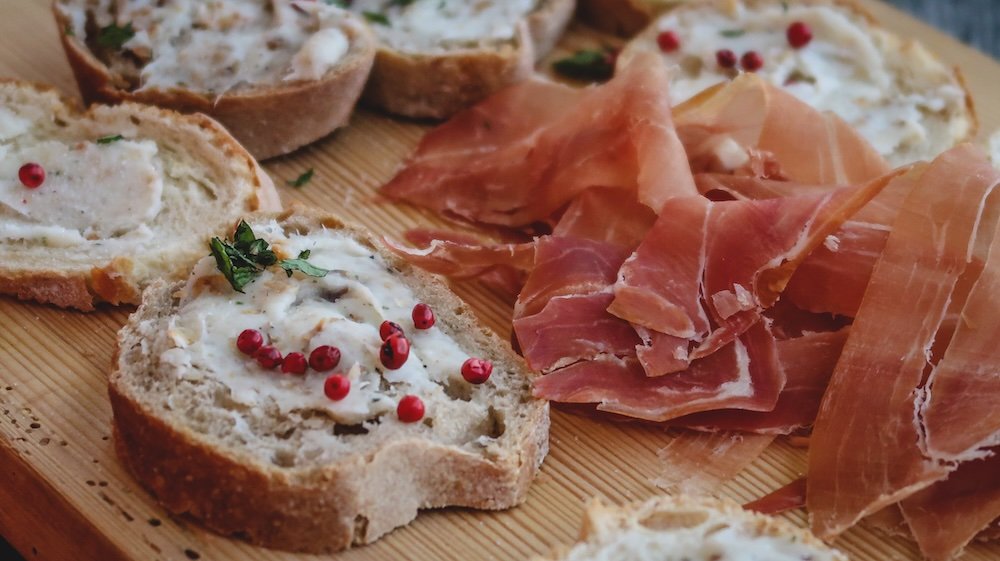
Local Meats & Cheeses
Tyrol’s mountainous terrain fosters livestock farming, giving rise to speck (cured ham) with a distinctive smoky tang. Alpkäse (mountain cheese) from high-altitude dairies can vary from mild to robust, often aged in cellars for extra depth. Small farm shops or markets let you taste artisanal cheeses—like Bergkäse or Camembert-style variations—perfect for charcuterie boards. Many inns incorporate these cheeses into soups, fondue-style dips, or sandwich fillings. You’ll also find venison or game meats in season, reflecting the region’s hunting culture. If you’re keen on farm-to-table experiences, rural villages sometimes host cheese festivals highlighting the best wheels of the harvest.
Tip: Look for “Sennerei” signs—these are dairies that sometimes welcome visitors to watch cheese-making and sample fresh curds.
Breads & Pastries
Tyrolean bread often includes rye or spelt, dense in texture but brimming with flavor. Bauernbrot (farmer’s bread) features a robust crust and malty undertones, usually served with speck or local cheese. On the sweeter side, Apfelstrudel stands out, though Tyrol also offers Buchteln (yeast buns filled with jam) or Kirchtagskrapfen (festive doughnuts). In the morning, you might wake to bread baskets loaded with rolls and pretzels, accompanied by homemade jams. Bakeries here pay homage to centuries-old recipes, and you’ll sense the pride behind each loaf or pastry.
Tip: Try a snack of bread + local butter—the simplest combos often reveal Tyrolean quality best.
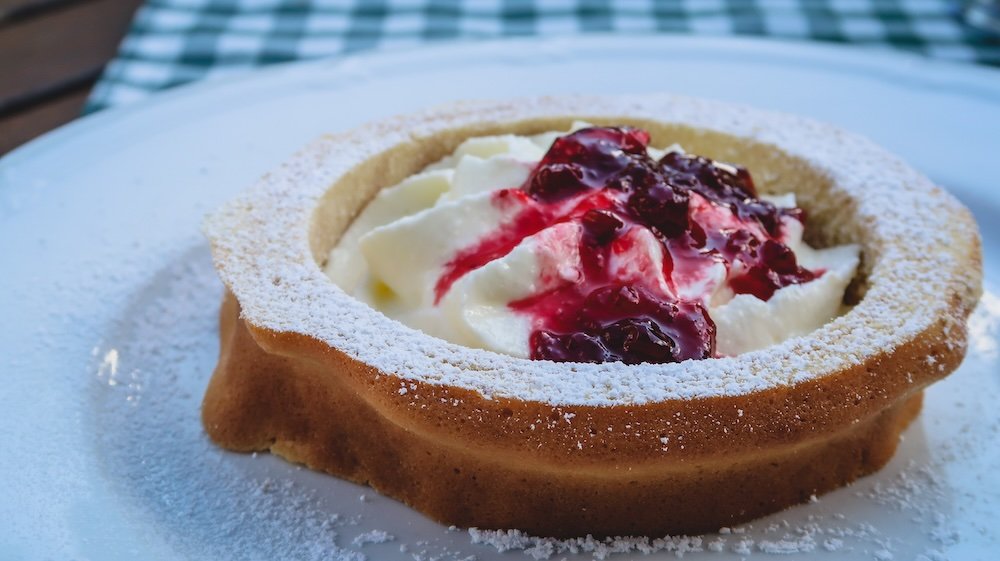
Desserts & Sweets
Outside the aforementioned strudel and dumplings, Tyrol also claims Kiachl—deep-fried dough topped with cranberry jam or powdered sugar. Seasonal fruit tarts incorporate orchard-fresh plums, cherries, or apricots. Pruegeltorte, as mentioned, adds showmanship with its cylindrical layering process. After a long hike, these treats feel well-earned and comforting. Pair sweet indulgences with robust coffee or herbal tea spiced with mountain-grown herbs. Dessert in Tyrol is about cozy satisfaction as much as sugar.
Tip: Look for “Marillenkuchen” if you’re visiting during apricot season—fresh, fragrant, and not overly sweet.
Drinks & Beverages
- Beer: Austrian lagers from big brands or local craft brews, typically light with a crisp finish.
- Schnapps: Tyrolean fruit brandies—like Obstler (apple/pear) or Zwetschke (plum)—function as post-meal digestifs.
- Herbal Teas: Alpine herbs such as edelweiss or chamomile appear in aromatic blends—ideal for warming up.
Tip: Go easy on schnapps—these homemade distillations pack a punch that can sneak up on you.
Eco & Farm-Fresh Emphasis
A big chunk of Tyrolean produce comes from small-scale farms prioritizing organic methods or minimal chemical use. Locals show pride in short supply chains, meaning your veggies might have traveled mere kilometers from field to plate. Farmers’ markets buzz with transactions for eggs, honey, or orchard fruit—worth a visit if you want raw, unpasteurized cheeses or fresh herbs. This closeness to the land fosters a “taste of place,” so even a simple tomato feels vibrant.
Tip: Check local market days—some towns have weekly events where you can snag produce or homemade spreads from the source.
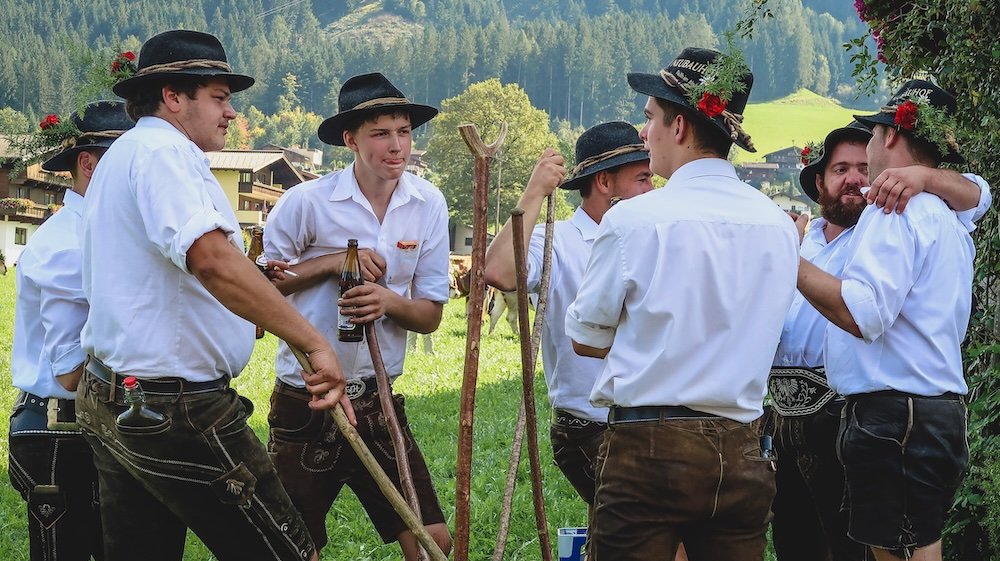
Tours For Visitors To Tyrol, Austria
Exploring Tyrol on your own is certainly rewarding, but guided tours can add extra layers of insight. If you’re sorting through things to do that promise deeper cultural immersion, scenic vantage points, or convenience, these curated experiences might be your ticket. Here’s a snapshot of tours that capture Tyrol’s heart and soul.
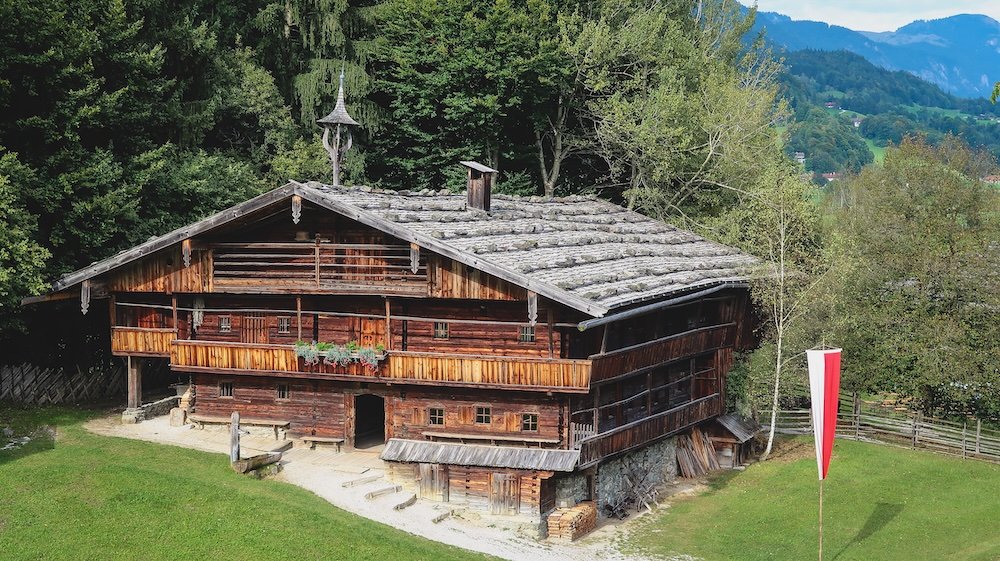
1) Alpine Farm Experience Tours
Alpine Farm tours typically bring you up winding roads to experience day-to-day life on a rustic mountain holding. You’ll see how farmers tend to cows, goats, or sheep, glean insights on artisanal cheese-making, and perhaps pitch in with small chores. Children especially love feeding animals, while adults appreciate tasting fresh produce—like homemade butter or tangy yoghurt. Many tours include a short hike or wagon ride, capping off with a hearty farmhouse lunch. Beyond the novelty, these experiences underscore Tyrol’s deep respect for nature and tradition, forging a bond between visitors and local stewards of the land.
- Booking: Through regional tourism centers or direct with farms that run tours.
- Language: Guides often speak English, but a few places rely on German only—ask beforehand.
- Tip: Some tours offer on-site farm stays if you want extended rural immersion.
Tip: Wear weather-appropriate clothing—farms can be muddy, especially after rainfall.
2) Cultural & Historical Walking Tours in Innsbruck
While Tyrol is famous for its countryside, Innsbruck stands as the region’s capital—ripe with baroque buildings, imperial palaces, and colorful facades. Guided walking tours unravel the city’s layers, from Emperor Maximilian I’s influence on the Golden Roof to modern street art peppering back alleys. You’ll pass through Old Town squares, see the shimmering Nordkette mountain chain overhead, and maybe learn about Tyrolean resistance stories or how the city morphs for winter sports. Many tours end near the Hofburg or a cozy café, letting you soak up alpine city culture. If you’re short on time, these tours crystallize Innsbruck’s essence in a couple of hours.
- Group Size: Typically small, fostering easy conversation with the guide.
- Evening Tours: Some operators run twilight walks, showcasing illuminated landmarks.
- Tip: Guides might offer insider tips on local restaurants or lesser-known viewpoints.
Tip: Check combined tickets—some tours package city highlights with a cable car ride up Nordkette.
3) Adventure Tours: Canyoning, Rafting, & Paragliding
For adrenaline junkies, Tyrol brims with adventure tour opportunities. Canyoning takes you through narrow gorges, rappelling down waterfalls and sliding across smooth rock formations. Rafting on the Inn or Ötztaler Ache delivers frothy rapids and team paddling fun. Meanwhile, paragliding outfits harness you to an instructor, letting you soar above valleys dotted with chalets. All gear—wetsuits, helmets, harnesses—usually comes included, ensuring safety is paramount. Post-activity photos or videos are often available, letting you relive the moment or brag to friends back home.
- Fitness Requirements: Operators define whether tours suit beginners or require intermediate skills.
- Seasonality: Spring and summer see higher water levels for rafting, while paragliding is possible in many months, weather permitting.
- Tip: Book in advance—weekends fill quickly, especially in peak summer.
Tip: Wear quick-dry clothes and sturdy shoes for canyoning—slippery surfaces can be part of the fun.
4) Food & Wine Trails
Food and wine tours in Tyrol often revolve around mountain huts, local dairies, and small vineyards near the Inn Valley. Guides lead you through short hikes or scenic drives, with stops to taste speck, artisan cheese, or orchard ciders. Some tours incorporate cooking demonstrations, letting you watch dumplings crafted from scratch or strudel dough expertly stretched. Others might highlight lesser-known wine pockets—like those perched on sunlit slopes, producing limited but refined bottles. This gastronomic journey blends the joy of sampling with the learning you’d get from orchard owners or wine producers.
- Duration: Ranging from half-day tastings to full-day farm-hopping itineraries.
- Hiking Factor: Some tours require moderate walking, but most remain accessible to all.
- Tip: Expect family-run operations—prepare to chat with multi-generational owners proud to share their produce.
Tip: Consider small-group tours—intimate settings foster better Q&A and a friendlier vibe among participants.
5) Scenic Train & Cable Car Tours
If you adore mountain panoramas yet want minimal hiking, a scenic train or cable car tour merges comfort with epic views. The narrow-gauge Achensee Railway or the Zillertalbahn, for instance, puff through the countryside, revealing woodlands, orchard fields, and glimpses of water. Cable car rides—like those to the Zugspitze (just beyond Tyrol’s border) or local peaks—offer lofty vistas without breaking a sweat. Tour packages often stitch train journeys together with a short guided walk or a stop at a mountaintop restaurant. This style suits all ages, bridging convenience with quintessential Tyrolean backdrops.
- Photo Tips: Aim for window seats on trains—some carriages have open-air sections for better angles.
- Regional Passes: Check if your lodging or tourism bureau pass covers certain rides.
- Tip: Some tours layer in historical commentary, adding depth to the scenic wonder.
Tip: Arrive early if the train is unreserved—peak times fill quickly, and you want the best seat for unimpeded camera views.
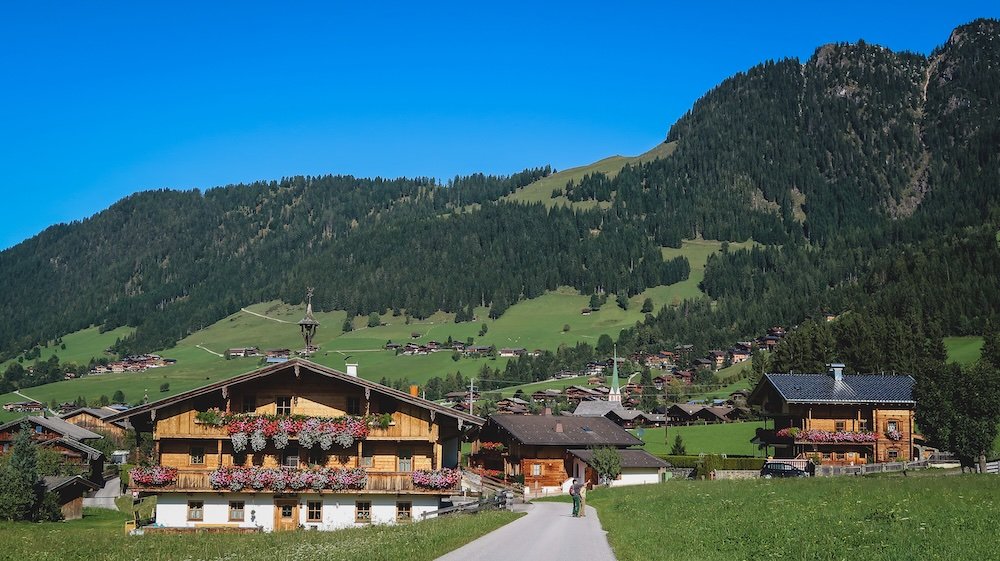
Tyrol Accommodations Guide: Hotels, Guesthouses and Hostels
Tyrol invites travelers to cozy chalets perched on mountainsides, modern city hotels near Innsbruck, and charming farm stays in scenic valleys. With so many things to do in the region, you’ll want lodging that suits your style—be it a plush spa escape or a friendly budget hostel. Below is a breakdown of how to choose accommodations that enhance your Tyrol adventure.
Hotels
Tyrol’s hotels range from four or five-star luxury wellness retreats to simpler city-based properties. Mountainous towns like Alpbach, Kitzbühel, or Seefeld host upscale resorts with spas, gourmet dining, and direct trail access. City hotels, often in Innsbruck, prioritize convenience—close to train stations, museums, and nightlife. In either scenario, look for references to panoramic balconies or “Bergblick,” if you crave an alpine view from your room. Many hotels integrate regional design—wooden beams, antler accents, and warm color palettes—yet still provide modern comforts like Wi-Fi and gyms. Price tags spike during ski season (December-March) and summer peaks (July-August), so plan and book early.
- Meal Plans: Half-board combos (breakfast + dinner) can save time and money.
- Wellness Extras: Some hotels boast indoor pools, saunas, or steam baths—perfect after a long hike.
- Language: Staff typically speak English; some also speak Italian or French, given Tyrol’s tourist diversity.
Tip: Check cancellation policies—mountain weather can shift your plans, so flexible bookings are wise.
Guesthouses (Gasthöfe) & Pensionen
For an intimate, family-run vibe, a guesthouse—often called Gasthof or Pension—offers fewer rooms, each styled with Tyrolean coziness. Common spaces may feature wooden benches, a crackling fireplace, and décor reminiscent of rural tradition. Breakfast is often homemade, with fresh bread, farm-sourced eggs, and a chatty host pointing out local trails. These smaller-scale lodgings can be cheaper than hotels while retaining comfort. You might even forge friendships with other guests if the dining area fosters communal seating. Plus, the direct link to local farmers or artisans can lead to insider tips on hidden vantage points or festivals.
- Atmosphere: Warm, down-to-earth, perfect if you appreciate a personal touch.
- Booking: Some rely on phone or email reservations rather than big booking sites.
- Seasons: Off-peak discounts appear in spring or fall, letting you enjoy mild temps sans crowds.
Tip: Ask about half-day or guided farm tours—some guesthouse owners double as enthusiastic local guides.
Hostels & Budget Lodging
Tyrol’s hostels cater to younger crowds, solo adventurers, or anyone eyeing thrifty stays. Towns like Innsbruck and popular ski villages often host at least one or two, with dorm rooms or basic private rooms. Expect communal kitchens, shared lounges, and a social buzz if you’re keen to meet fellow travelers. Cleanliness and comfort vary—read recent reviews for the lowdown. This no-frills approach suits hikers or backpackers who plan to spend most of their day out exploring. Evening downtime in a hostel common room can birth new travel ideas or instant friendships.
- Price Points: Typically €20-€40 for dorm beds, more for private rooms.
- Facilities: Lockers, laundry machines, plus staff proficient in local tips are common.
- Location: Urban hostels or near main transit hubs; some rural hostels are also near trailheads.
Tip: Carry earplugs—dorm life can get noisy if folks come in late or wake early for sunrise summits.
Alpine Huts & Farm Stays
For a truly immersive experience, consider remote alpine huts (Hütten) or farm stays perched high in the hills. Many huts require hiking in—some are only accessible on foot or by cable car. Facilities may be basic (shared bunkrooms, limited electricity), but the payoff is jaw-dropping dawn vistas and communal camaraderie. Farm stays, on the other hand, can be more comfortable, sometimes offering private rooms plus the chance to observe daily chores or sample fresh dairy. Both options envelop you in mountain rhythms, where star-filled skies replace city lights.
- Reservations: Alpine huts get booked quickly in peak seasons—confirm ahead for guaranteed bunk space.
- Meals: Huts often provide half or full board with simple hearty dishes.
- Atmosphere: Rustic yet unforgettable—morning cowbells or goats bleating might be your alarm clock.
Tip: Check membership (e.g., Alpenverein) for discounted hut overnights if you’re an avid mountaineer.
Booking Tips & Seasonal Considerations
- Peak Times: Winter skiing (Dec-Mar) and summer hiking (Jun-Aug) see surges, so snag lodging months ahead.
- Off-Season: Late spring or fall offer cost savings, milder crowds, and often stunning foliage.
- Cancellation: Mountain weather can force changes—flexible bookings reduce stress.
Tip: Ask about local guest cards—some accommodations partner with tourism boards, giving you free bus rides or attraction discounts.
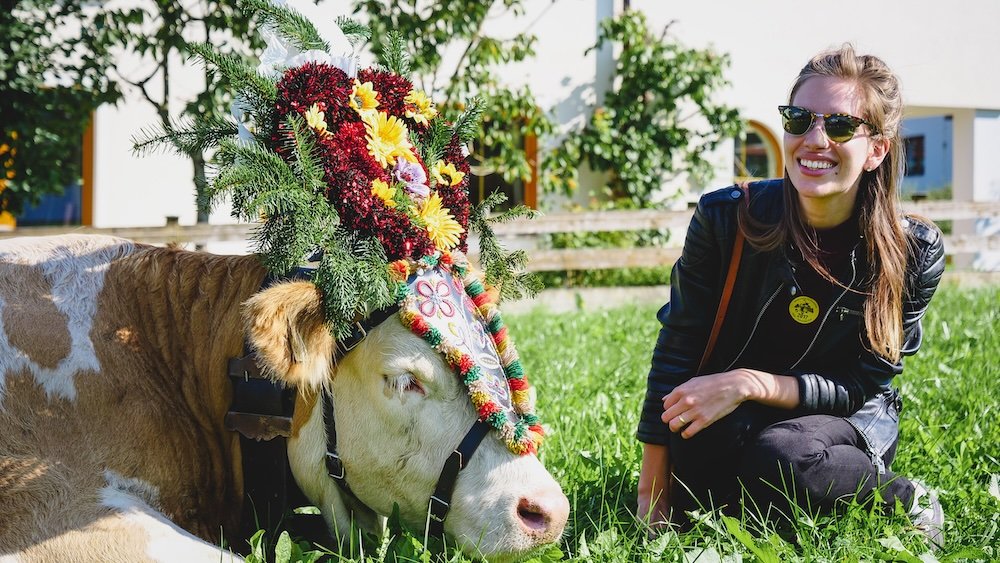
Day Trips From Tyrol, Austria
When Tyrol’s mountain wonders spark a thirst for broader horizons, numerous day trips beckon. Though Tyrol itself overflows with things to do, stepping beyond its borders or venturing to nearby Austrian gems can amplify your Alpine adventure. Below are five recommended day excursions—each distinct in flavor—accessible within a few hours’ travel.
Our Travel Video From Salzburg, Austria on Samuel and Audrey YouTube Channel: Nomadic Samuel + That Backpacker hosting
1) Salzburg: City of Mozart and Baroque Splendor
From Innsbruck or central Tyrol, you can catch a train or drive to Salzburg, famed for its baroque skyline and musical heritage. The Hohensalzburg Fortress looms overhead, a prime vantage offering panoramic views of church domes and the Salzach River. A walking tour might include Mozart’s Birthplace, the Getreidegasse shopping street, and Mirabell Gardens, known for “The Sound of Music” scenes. Time your trip to catch a classical concert inside the fortress or a local church, immersing you in the city’s melodic pulse. Street cafés dish out apple strudel or Sachertorte, bridging sweet indulgences and centuries-old décor. Even a one-day taste leaves a lingering impression of Salzburg’s elegant spirit.
- Travel: Roughly 2 hours by train from Innsbruck, slightly more by car.
- Activities: City tours, fortress climb, leisurely river stroll.
- Tip: Some shops push “Mozartkugeln” (chocolates) as souvenirs—taste a few for a sweet memory of your Salzburg foray.
2) Achensee & Pertisau for Lake Views
Achensee, nicknamed the “Tyrolean Sea,” boasts turquoise waters hugged by dramatic peaks. A quick drive or train+bus link from Innsbruck whisks you to Pertisau, one of the lake’s main access points. Boat cruises reveal the lake’s shimmering expanse, while shoreline trails lure hikers and bikers wanting crisp mountain air. Fishing fans might snag trout or char, or you could dip your toes in designated swim spots. In winter, the region morphs into a cross-country skiing haven, with scenic tracks hugging the lake’s perimeter. Achensee’s trifecta of water, forest, and mountain draws you in, whether you seek a serene lunch or active day outdoors.
- Boat Rides: Hop-on/hop-off stops let you explore multiple villages along the lake.
- Lakeside Inns: Taste freshwater fish or local dumplings while admiring the water’s sparkle.
- Tip: Consider renting a paddleboat—sunny days plus calm waters equal tranquil floats.
3) The Zugspitze: Germany’s Highest Peak
Though in Germany, the Zugspitze is near Tyrol’s border and manageable as a day trip, especially from Ehrwald. A cable car (or cogwheel train from the German side) transports you up to 2,962 meters, unveiling endless Alpine peaks stretching across Austria, Switzerland, and Germany. At the summit, an observation platform, panoramic terrace, and a small museum detail its mountaineering history. Some visits coincide with skiing at the glacier area, or you might just sip a warm drink while gazing at the horizon. The air up top is crisp, and even short walks on the snowfields prove thrilling. The vantage redefines “on top of the world,” meshing deep-blue skies with raw mountain might.
- Border Crossing: If you drive from Tyrol, ensure you have ID for any random checks.
- Weather: Be prepared for sudden temperature drops—pack layers.
- Tip: Arrive early—cable car queues can lengthen, especially on bright weekends.
4) South Tyrol (Italy) for a Cultural Twist
If you crave a slice of Italy’s Dolomites region, a day trip to South Tyrol beckons. Towns like Bolzano mix Austrian influences—think German signage, baroque churches, hearty dumplings—yet also exude Italian flair in espresso bars and gelato shops. A short bus ride or cable car from the valley might lead you to Alpe di Siusi, Europe’s largest high-altitude meadow, where jaw-dropping Dolomite spires frame gentle pastures. You can also drop by the Ötzi Museum to glimpse the world-famous ice mummy from 3,300 BC. The cultural fusion of German-Italian in language, cuisine, and architecture stirs an intriguing new dimension into your Tyrolean holiday.
- Travel Times: From Innsbruck, about 2 hours by car or 3 hours by train/bus combos.
- Must-Try Dish: Speckknödel meets pasta—only in South Tyrol’s hybrid kitchens.
- Tip: Explore Bolzano’s arcades—medieval walkways lined with boutiques and epic arches.
5) Highline179 & Ehrenberg Castle Ruins near Reutte
In northern Tyrol near Reutte, the Highline179 footbridge stretches dramatically between two fortification ruins. Suspended 114 meters above ground, this walkway offers a heart-pounding yet secure vantage of valleys and mountain ridges. At one end lies Ehrenberg Castle ruins, a relic from the Middle Ages, while the other side accesses Fort Claudia. Wind can sway the footbridge slightly, injecting an adrenaline dose for adventurous spirits. Interpretive signs detail the castle’s past, from battles to medieval trade routes. Pairing history with a dash of thrills, it’s a day trip that cements Tyrol’s reputation for blending heritage and nature.
- Bridge Length: ~400 meters, making it one of the longest pedestrian suspension bridges in the world.
- Entry Fee: A ticket covers the bridge and sometimes museum exhibits.
- Tip: Wear steady shoes—the metal grating can feel daunting if you’re prone to vertigo.
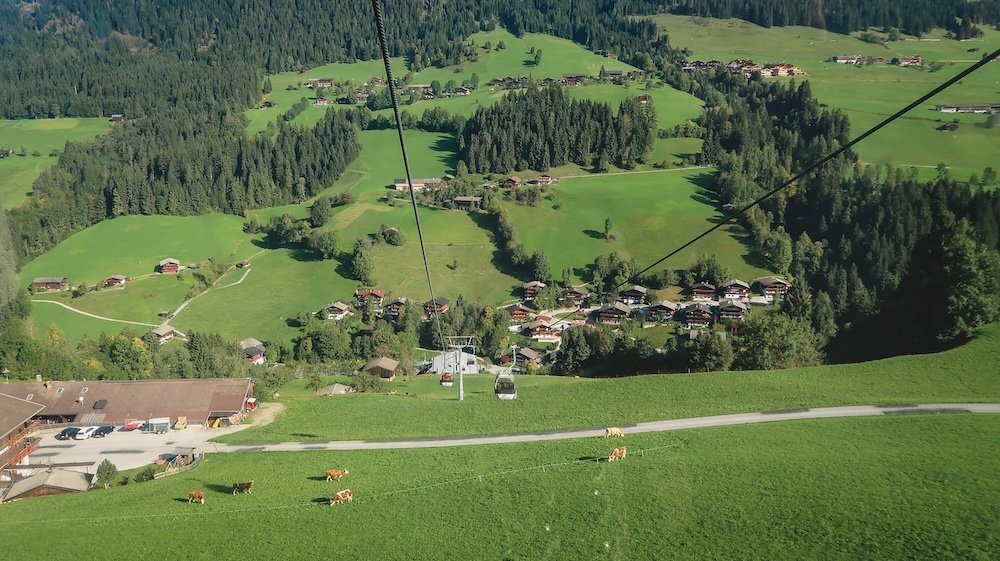
Tyrol Transportation Guide
Navigating Tyrol’s mountainous terrain might appear challenging, but a well-organized network of roads, trains, and buses simplifies your things to do itinerary. Whether you’re focusing on Innsbruck or small villages, consider these transport tips to optimize your alpine travels.
Trains
ÖBB (Austrian Federal Railways) covers major Tyrolean hubs like Innsbruck, Kufstein, and Landeck, with some lines stretching toward Italy or Germany. Trains often slice through scenic valleys, letting you admire peak-laden skylines from your window seat. Schedules can be frequent on main routes, though smaller mountain branches run less often—especially weekends or holidays. Booking advanced tickets for long-distance routes (like Vienna to Innsbruck) can net discounts. Short hops within Tyrol are straightforward: buy tickets at station machines or via the ÖBB app. Trains typically boast cleanliness, comfortable seats, and sometimes onboard snack trolleys.
- Regional Passes: Consider a Tyrol-based pass if you’re shuttling frequently among local towns.
- Innsbruck Hub: The central station links city trams, buses, and out-of-province lines for easy transfers.
- Tip: Grab seats on the right if traveling west from Innsbruck for better mountain views (or left if heading east).
Buses & Postbuses
For places trains don’t reach, buses step in, particularly Postbuses (yellow in color) that tackle routes across mountainous roads. They connect villages perched on steep slopes, ensuring daily commutes and tourist access. Timetables are posted at stops or on the Postbus website, but watch out for reduced service on Sundays or winter evenings. In many Tyrolean valleys, buses align with train arrivals, easing multi-leg journeys. Fares are typically paid to the driver or via local transit apps. If you prefer scenic over speed, these bus rides reveal hidden hamlets, dense forests, and dramatic gorge views along curvy routes.
- Multi-Hour Trips: Some lines run from Innsbruck into deeper valleys, so bring water or snacks.
- Crowds: Mornings can be busy with locals heading to markets or students traveling to school.
- Tip: Plan a window seat—you’ll want to snap photos or simply daydream at the alpine vistas.
Driving & Car Rentals
Renting a car offers maximum freedom, letting you chase remote vantage points or orchard-flanked backroads. Motorways like the A12 (Inntal Autobahn) or A13 (Brenner Pass) connect major Tyrolean areas, though you’ll need a vignette for Austrian highways. In winter, snow chains or winter tires are mandatory in certain conditions—pay attention to local regulations. Parking in big towns is typically metered or limited to garages, and mountain villages may have smaller lots near lifts or tourist centers. The scenic payoff is immediate: you can pause spontaneously for photo ops or local farm shops.
- Fuel Costs: Slightly above EU average; fill up in bigger towns for better prices.
- Mountain Driving: Switchback roads require caution—take it slow on sharp turns, especially if you’re unused to altitude.
- Tip: Check weather forecasts before tackling high mountain passes—some close if snowfall is heavy.
Local Innsbruck Transit
If Innsbruck is your base, a robust tram and bus network simplifies city exploration. Single tickets, day passes, or the “Innsbruck Card” grant free rides plus potential museum entries. The tram extends to spots like the Nordkette cable car station, bridging urban convenience with alpine adventure. With a short walk or transfer, you can reach the old town’s Golden Roof, the Hofburg palace, or the university district. Night lines run on limited schedules but suffice if you’re out late at a festival or restaurant.
- Ticket Purchase: Machines at main stops, or use a mobile app for contactless payment.
- E-Scooters: Also appear around city corners if you fancy an eco-friendly, quick hop.
- Tip: Some lines pass the Bergisel Ski Jump—ask if you want a scenic route or direct approach.
Cable Cars & Lifts
In mountainous Tyrol, cable cars and lifts are more than tourist gimmicks. They’re integral, whisking you to high-altitude meadows, ski runs, or hiking trails. Each major region—Zillertal, Alpbach, Kitzbühel—boasts multiple lifts. Timetables vary by season; summer sees hikers and sightseers, while winter is prime for skiers and boarders. Fares can get pricey, yet the panoramic payoff often justifies the cost. Bring a camera—exiting a gondola to a 360-degree mountain vista is unforgettable.
- Combined Tickets: Some passes bundle multiple cable cars, public transport, and museum entries.
- Peak Hours: Mornings can see lines of anxious hikers or skiers. Afternoon rides are calmer.
- Tip: Check windy conditions—cable cars sometimes halt if gusts are too strong.
Biking & E-Bikes
If you prefer self-propelled travel, cycling in Tyrol is growing in popularity, thanks to improved bike lanes and e-bike rentals. Many valleys offer relatively flat routes along rivers, with mapped trails ensuring you won’t get lost. E-bikes help conquer mild slopes, bridging towns or climbing to vantage points without physical strain. Expect dedicated signage, scenic rest stops, and the occasional Alpine hut selling cold drinks. Some public buses or trains even allow bike transport, letting you skip awkward uphill stretches or return if you’re tired.
- Rental Shops: Towns like Mayrhofen, Alpbach, or Innsbruck bristle with e-bike and standard bike providers.
- Helmet: Advised for safety—mountain roads can see fast cars or tight corners.
- Tip: Plan battery charge if e-biking longer distances—ask about recharge stations en route.
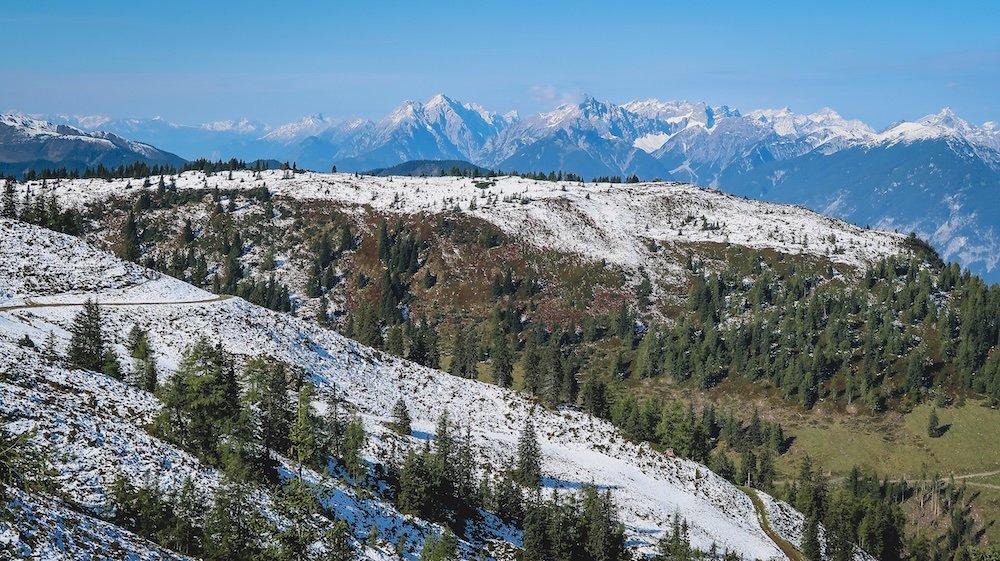
Tyrol Travel Guide: Conclusion
Tyrol is a place that leaves footprints on your soul. Its tapestry of lofty peaks, cozy chalets, and hearty traditions invites you to slow down and soak in mountain life. At first glance, you see pristine trails, sparkling snowcaps, or meadows bursting with summer blooms. Dig deeper, and the region reveals centuries of resilience—farmers forging a living from steep fields, artisans weaving ancient craft into modern goods, families cherishing festivals that keep ancestral spirit alive. This duality of timelessness and forward-thinking is what defines Tyrol’s enduring appeal.
We’ve walked through an array of things to do: sleeping in old-world farmhouses, indulging in Kasspatzen at a rustic gasthof, or witnessing the jubilant Almatrieb parade. There’s also e-biking for the active souls, gorge hikes that test your sense of wonder, and gondola rides that elevate your perspective, both literally and metaphorically. If your passion tilts toward culture, Tyrol’s museums and cooking demos slip you behind the scenes of rural traditions—like that mesmerizing Pruegeltorte spinning over an open flame. Or maybe you savor simpler joys: sipping coffee while gazing at summits from a café terrace.
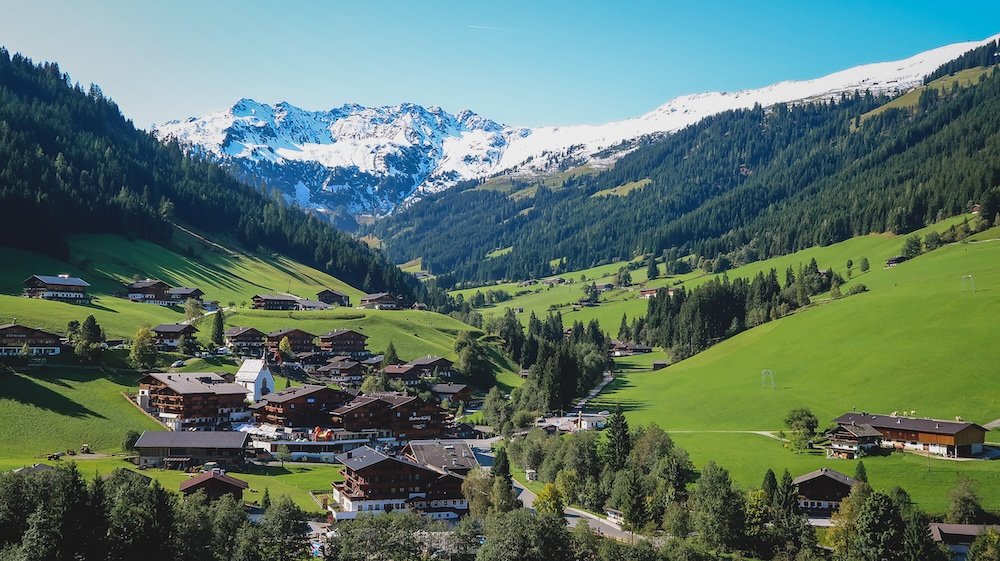
Final Thoughts
Logistics needn’t be daunting, either. Public transport, from trains to cable cars, runs with efficiency. For those who crave autonomy, rental cars thread you through scenic byways. And if you prefer guided tours or curated experiences, we’ve outlined how local experts can deepen your understanding of the region’s heritage. Lodging choices mirror the region’s diversity—farm stays exude authenticity, while hotels or B&Bs offer a comfortable perch to recharge. The synergy of modern tourism infrastructure and Alpine tradition fosters an easygoing yet immersive trip.
And beyond Tyrol’s borders? Quick day trips whisk you to Germany’s Zugspitze, Swiss Rhine Falls, or even the Italian Dolomites in South Tyrol. That cross-border fluidity underscores Tyrol’s position at the heart of the Alps, bridging cultures while retaining its distinct identity. Each foray beyond invites fresh experiences that fold neatly back into your Tyrolean base, letting you compare landscapes and customs with each crossing.
Ultimately, Tyrol thrives on warmth—both the literal warmth of wood-fired stoves in winter and the figurative warmth of locals eager to share their corner of the Alps. Gute Reise—safe travels—and may Tyrol’s charm stay with you long after the last alpine sunset has faded from view.
